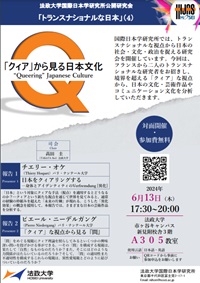【Event Information】Hosei University Research Center for International Japanese Studies Transnational Japan Workshop Series(4) “Queering” Japanese Culture June 13th (Thu), 20242024/05/17
Hosei University Research Center for International Japanese Studies
Transnational Japan Workshop Series(4)
“Queering” Japanese Culture
「クィア」から見る日本文化
As part of the Transnational Japan workshop Series at HIJAS, we cordially invite you to our upcoming event, “Queering” Japanese Culture. Thierry Hoquet and Pierre Niedergang will examine Japanese literature, manga, visual culture, as well as communication culture from a “queer” perspective.

■ Date/Time: June 13th (Thu), 2024 17:30~20:00
■ Location
Hosei University Ichigaya Campus, Shin Mitsuke Building, 3rd FL Room A 305 (Face-to-face format)
10 minutes walk from Iidabashi or Ichigaya stations
Access: https://www.hosei.ac.jp/english/about/maps/access/ichigaya/
Campus Map: https://www.hosei.ac.jp/english/about/maps/campus/ichigaya/
■ Language: Japanese and English
■ Free, Preregistration is required.
■ Presenter :
Thiery Hoquet (Université Paris Nanterre)
Pierre Niedergang (Université Paris Nanterre)
■ Chair: Kei Takata (Hosei University)
◆Please register in advance using the application form below.
Application form →https://forms.gle/Y4t4A1MS5tSYFBwk9
*Pre-registration deadline: 3pm, Thursday 13 June 2024.
[Presentation Abstracts]
Queering Japan: a Verfremdung [estrangement] of Bodies and Identities
Thierry Hoquet (Profressor, Paris Nanterre University)
“Queer” is often associated with a point of view coming from sexual minorities (LGBTQIA+). However, the “Q” in this acronym does not mean “Queer” but “Questioning”. Thus, “Queer” is not one of the LGBTQIA+ identities, but a method that encompasses them all. Note that the verb “to queer” is often used in the active -ing form: queer-ing. This designates a gesture, an act or a change of outlook. Thus, “queering” is revisiting from a new and subversive angle a body of work or an object venerated by standard culture. What happens when we apply the queering method (or point of view) to the object “Japan”? The idea of this presentation is that an effect of “estrangement” (Verfremdungseffekt) occurs when the object is seen from a queer perspective. This new perspective might give us some “glimpses of the future”, as in the case of science-fiction works (a reading suggested by Fredric Jameson 2005, after Darko Suvin 1979). Using this category of “estrangement”, we will study different Japanese works of art: two works situated in the Tokyo underground: the novel Forbidden colors (禁色Kinjiki) (1952) by Mishima Yukio and the movie Funeral Parade of Roses (薔薇の葬列, Bara no Sōretsu) (1969) by Matsumoto Toshio. Then we will comment on different photographic artworks: the photobook Barakei (1971) by Eikoh Hosoe and the photograph “Elder Sister”, by Morimura Yasumasa (1993). Finally, we will study the manga My Brother’s Husband (弟の夫, Otōto no Otto) (2014-2017) by Tagame Gengorô (田亀源五郎).
Queering “Aida” (間)
Pierre Niedergang (PhD candidate, Paris Nanterre University)
The Japanese notion of “in-between” or 間 is a complex and elusive notion that receives various everyday applications as well as technical meaning (in aikido 合気道 or in philosophical approaches of psychiatry, for example, see: Kimura Bin, 1988). From a queer perspective, what interests us in 間 is its relationships with norms. 「間が悪い」or 「間合い」are examples of Japanese expressions that show that there are norms that distinguish “adequate in-betweens” and “inadequate in-betweens”, whether 間 is considered temporally or spatially. From this starting point, we can ask, in the light of queer theory, a set of interesting questions concerning these norms structuring 間: even if 間 should be understood in its vital dimension, are the norms structuring 間 “natural”? What kind of power relation do they support? How are these norms structuring the (in)adequacy of 間 linked to heteronormativity? How do these norms also set the boundaries of what we call human (人間)? Then, what could “looking at間 with a queer eye (or queering ‘aida’)” mean?
Enquiries regarding this matter should be addressed to
Hosei University Research Center for International Japanese Studies (HIJAS)
E-mail: nihon@hosei.ac.jp

